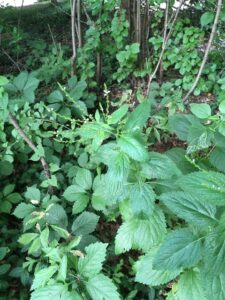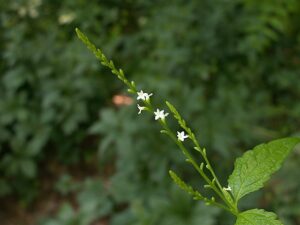White Vervain
Verbena urticifolia
By Linda Shuster, WORC Board Member-at-Large (2022)

White vervain (sometimes called nettle-leaved vervain or white verbena) is a member of the Verbenaceae family. It is found in most central to southern Lower Peninsula counties and in several counties in the Upper Peninsula. White vervain grows in different types of deciduous forests, as well as along borders and trails, in swamps and thickets, and along roadsides and fencerows. I discovered it in abundance on the edge of my yard under the tree canopy where we had been working to dig up Vinca minor, or periwinkle/myrtle.
White vervain is an annual, biennial, or short-lived perennial. It grows to between 3′ and 6′ tall. The leaves are opposite and approximately 6″ long and 2 1/2″ wide. They are toothed and can be slightly softly hairy. The flowers grow on many slender stalks from the leaf axil near the top of the plant. They are white and very small, only about 1/8″ across, with five petals. White vervain can be started from seed, but it is short-lived.

While sometimes described as a weed (e.g., Virginia Tech includes it in their list of weeds), it has high ecological value. Although the flowers are tiny, the nectar and pollen attract a variety of bees, wasps, and butterflies. The larvae of the Verbena Moth (Crambodes talidiformis) and the Vervain Leaf Midge (Clinodiplosis verbenae) feed on the foliage, as do flea beetle species (Longitarsus suspectus), the Verbena Aphid (Macrosiphum verbenae), and the Two-striped Grasshopper (Melanoplus bivittatus). In addition, the seeds are eaten by songbirds, while mammalian species, such as deer, generally find its bitter foliage unattractive. White vervain has long been used medicinally, including as an aid for the flu and for gynecological purposes.
In summary, although it can be weedy, and the small flowers are not showy from a distance, white vervain is a highly beneficial plant for the native garden. It can be controlled to prevent it from becoming weedy, and it is unlikely to be eaten by deer or rabbits. The major downside is that it is a short-lived plant. If you discover it in your yard, consider letting it stay as long as it can.
Sources:
University of Michigan Herbarium
Image Sources:
Linda Shuster
